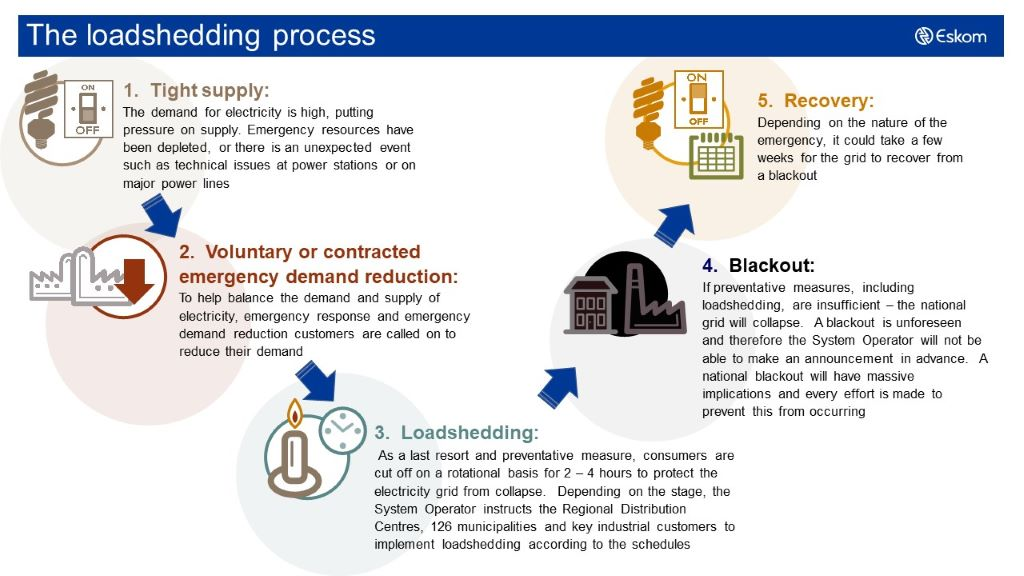Gauteng Power Cuts Explained: Load Reduction and Load Shedding Compared

Power cuts remain a major challenge for Gauteng, South Africa’s economic hub, throughout 2025. Understanding the difference between load reduction and load shedding is essential for residents and businesses affected by intermittent electricity supply. This article explains these two related processes in simple terms while exploring their causes, impacts, and how people can manage them.

RELEVANT ARTICLE: Eskom Strengthens Grid in Preparation for G20 in Johannesburg
Table of contents
- What Are Load Reduction and Load Shedding?
- How Load Shedding Works in Gauteng
- How Load Reduction Works in Gauteng
- Why Do Power Cuts Happen in Gauteng?
- Impact of Power Cuts on Gauteng Residents and Businesses
- Coping Strategies During Power Cuts
- Eskom and City Power’s Efforts to Manage Power Cuts
- Why the Power Crisis Persists in Gauteng
- A More Stable Power Future?
- Understanding and Managing Gauteng’s Power Cuts
What Are Load Reduction and Load Shedding?
Both load reduction and load shedding are strategies used to balance electricity supply and demand on the power grid.
- Load reduction means lowering electricity consumption voluntarily or via restrictions to reduce pressure on the grid.
- Load shedding refers to planned, controlled blackouts where power is temporarily switched off in certain areas to prevent the entire grid from collapsing.
In Gauteng, these measures help manage limited electricity supply from Eskom and local utilities like City Power.
How Load Shedding Works in Gauteng
Load shedding is more drastic and involves rotating power outages across different areas.
- Eskom schedules blackouts in blocks of hours.
- These blocks are assigned to different suburbs to ensure no area loses power for too long continuously.
- Load shedding happens in stages from 1 to 8, based on the severity of supply shortages.
For example:
- Stage 1 might mean 1,000 MW of power is cut, causing a few hours of outage.
- Stage 6, which Gauteng experienced in early 2025, involves cutting up to 6,000 MW with outages lasting up to 12 hours for affected areas.
Load shedding prevents the grid from overstressing and helps maintain overall system stability.

How Load Reduction Works in Gauteng
Load reduction is a demand-side management tactic. When electricity use is very high, especially during peak hours, the grid risks becoming overloaded. To avoid this:
- Consumers: households, businesses, and industries are encouraged or sometimes required to reduce their electricity use.
- This might mean switching off non-essential appliances, lowering heating or cooling, or postponing energy-heavy activities.
- Utilities may also signal specific industries or large users to decrease consumption temporarily.
This approach helps delay or reduce the need for load shedding by easing grid stress.
ALSO READ: Load Reduction Schedule: These Areas Will Be Affected This Week
Why Do Power Cuts Happen in Gauteng?
Several factors cause Gauteng’s power shortages:
- Aging Eskom Power Plants: Much of the energy comes from older coal-fired stations prone to breakdowns and maintenance issues. Units at Majuba, Matimba, and Camden stations frequently trip, reducing generation capacity.
- Unplanned Outages: Unexpected equipment failures occur regularly, causing sudden supply drops.
- Electricity Theft and Illegal Connections: Theft of copper cables and illegal tapping of power lines lead to outages and damage to infrastructure.
- Seasonal Demand Peaks: Cold winter mornings and hot summers increase heating and cooling use, pushing demand beyond supply.
- Limited Renewable Energy Contribution: Despite growth in renewables, current capacity is insufficient to offset coal plant outages fully.
Taken together, these factors strain Gauteng’s power grid, requiring load management measures.
Impact of Power Cuts on Gauteng Residents and Businesses
Power interruptions inconvenience daily life and hurt the economy:
- Homes: Blackouts disrupt cooking, heating, lighting, and home security systems.
- Businesses: Retail shops, restaurants, and manufacturing face losses due to halted operations and spoiled stock.
- Schools and Healthcare: Power outages interfere with education and critical health services.
- Traffic and Safety: Traffic lights stop working, increasing accident risks, while security systems may fail.
Many households invest in backup generators or uninterruptible power supplies (UPS), but these are costly solutions.
Coping Strategies During Power Cuts
Residents and businesses can better manage power cuts with simple steps:
- Stay Informed: Follow Eskom and City Power schedules for planned outages to prepare.
- Use Energy Wisely: Reduce electricity use, especially during peak hours, to support load reduction efforts.
- Have Backup Plans: Use battery-powered lights, keep devices charged, and have alternative cooking options.
- Protect Appliances: Switch off electrical devices during outages to avoid damage from power surges when supply returns.
- Support Local: Shop at markets that may be less affected by blackouts and use daylight when possible.
Cooperation from everyone helps ease the strain on Gauteng’s electricity system.

Eskom and City Power’s Efforts to Manage Power Cuts
Eskom and City Power continue working to improve supply reliability:
- Maintenance: Prioritising repairs on older plants to reduce unplanned breakdowns.
- Infrastructure Upgrades: Investing in new power generation and grid modernisation projects.
- Demand Management: Promoting energy efficiency and encouraging load reduction campaigns.
- Renewable Integration: Increasing solar, wind, and battery storage projects to diversify energy sources.
Despite improvements, supply challenges remain, and load shedding will persist until infrastructure stabilises and more capacity comes online.
Why the Power Crisis Persists in Gauteng
The root causes of power cuts include:
- Historical Underinvestment: Years of insufficient maintenance and delays in expanding generation capacity.
- Financial and Governance Issues: Eskom has faced financial difficulties and management challenges impacting operations.
- Rapid Demand Growth: Gauteng’s growing economy and population drive electricity needs higher.
- Infrastructure Complexity: Integrating new energy sources and upgrading ageing grid assets is a long, complex process.
Until these systemic issues are resolved, load reduction and load shedding remain necessary.
A More Stable Power Future?
The South African government and Eskom have ambitious plans:
- Adding new renewable and gas-fired plants.
- Upgrading transmission infrastructure.
- Encouraging private sector involvement in energy generation.
- Promoting household solar installations.
These efforts aim to reduce dependence on coal and improve supply reliability by 2030. Meanwhile, Gauteng residents should stay aware and prepared for ongoing power management measures.
Understanding and Managing Gauteng’s Power Cuts
Gauteng’s power cuts in 2025 result from complex supply and demand challenges.
- Load reduction is voluntary or mandated energy saving to ease grid stress.
- Load shedding involves planned blackouts to protect the national grid.
- Both play important roles in managing limited electricity supply.
With ongoing maintenance, infrastructure projects, and consumer cooperation, Gauteng is working towards fewer power interruptions. Until then, knowing the processes involved and preparing accordingly will help households and businesses cope better with outages.
8 days without electricity? See how one Tshwane resident is fighting back, and what it means for you. Click here to read the story.




